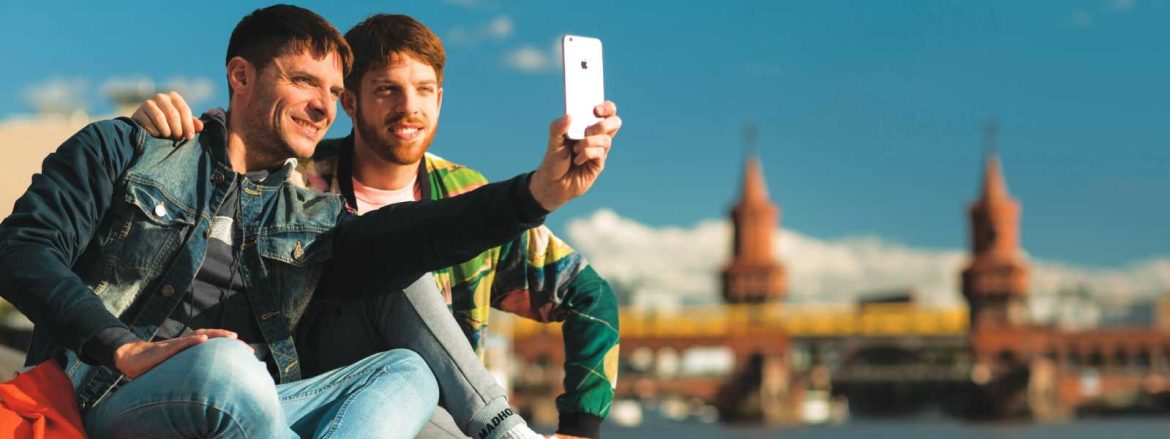Each plate is accompanied by an equally inventive miniature cocktail, mixed from an impressive array of bottles, decanters, and eyedroppers. What pairs well with balsamic eggplant confit seasoned with licorice salt? Well, a potion of muscatel wine, oolong tea, and cardamom eau de vie, of course!
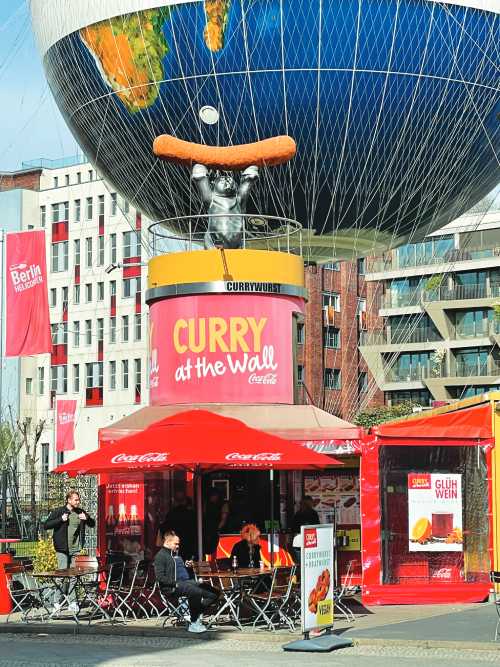
Curry Wurst Vendor (Photo by Jim Gladstone)
I ate at the four seat kitchen counter, so I could chat with the chef and Adam, a charming barman, who pointed me to The Truffle Pig around the corner for after dinner drinks. To get to this speakeasy-style hideaway, ring the bell on the back wall of the Kautz and Kiebitz pub. From fanciful options like the Dolce & Banana to a stiff mix of bourbon, bitters, amaro and blood orange called Goodfellas, the mixology here is top notch and well-balanced.
Other Berlin bars notable for a little something extra are Fragrances, in the Ritz-Carlton, where you choose your favorite scent from a selection of classic perfumes and are served a cocktail that complements it; and Bellboy, where incredibly theatrical presentations include drinks presented in giant seashells, ice shaped like flowers, and an outré libation called “A Lesson in Fisting” that’s served in a clenched ceramic glove (while the drink packs a punch, it doesn’t seem quite right to call it a cocktail).
Bellboy is the junior iteration of an original location based in Tel Aviv; one of a burgeoning number of businesses being established in Berlin by Jewish entrepreneurs from around the world, including Australian native Dov Selby, the owner of Fork & Walk food tours, who are relocating here to embrace the city’s creative vibe and helping it move beyond past infamy.
Before heading off to tipple in other parts of town, don’t leave Coda’s Neukolln neighborhood without a stop at Silver Future, a kitschy dive bar which draws a truly diverse queer crowd of hims, hers, and thems, and frequently hosts drag shows that are sloppily avant garde.
Humbolt Forum
Opened in 2021, the Humboldt Forum on Museum Island is a spectacular new cultural complex located at a landmark location with a tumultuous 800 year history as a monastery, royal palace, and political headquarters, remnants of each of which have been incorporated in its latest reconstruction. In addition to tours and exhibitions exploring the controversial evolution of the site itself, the forum also showcases major national collections of Asian, African, Antipodal, and American ethnological artifacts reflecting Germany’s colonial past along with provocative presentations on controversies associated with that history. An array of special temporary exhibitions on subjects from modern art to the sciences populate additional halls and galleries. A magnificent rooftop observation deck overlooks the Spree River and surrounding cityscape. Schlossplatz, Museuminsel. Tel: 49-30-99211-8989. www.humboldtforum.com
WHERE THE GAYS ARE
Today, Berlin is home to one of the world’s strongest, most visible, and most accepted queer communities. If your historical memory reaches back no further than WWII, this may seem perplexing, but long before that dark chapter, the city had established its reputation as a haven for gay men and lesbians.
Alongside a bend in the Spree just north of the Tiergarten is yet another memorial. This one, though, feels more celebratory than solemn. Honoring “The First Homosexual Emancipation Movement” this arrangement of six brightly painted 13-foot-tall sculpted calla lilies with petals in the colors of the traditional rainbow flag was inspired by the pioneering initiatives of queer Berlin lawyer Karl Ulrichs. Calla lilies were chosen because each flower has visual and reproductive characteristics evocative of both male and female human sexuality. (Who knew my Berlin studies would include a brief course in botany?!)
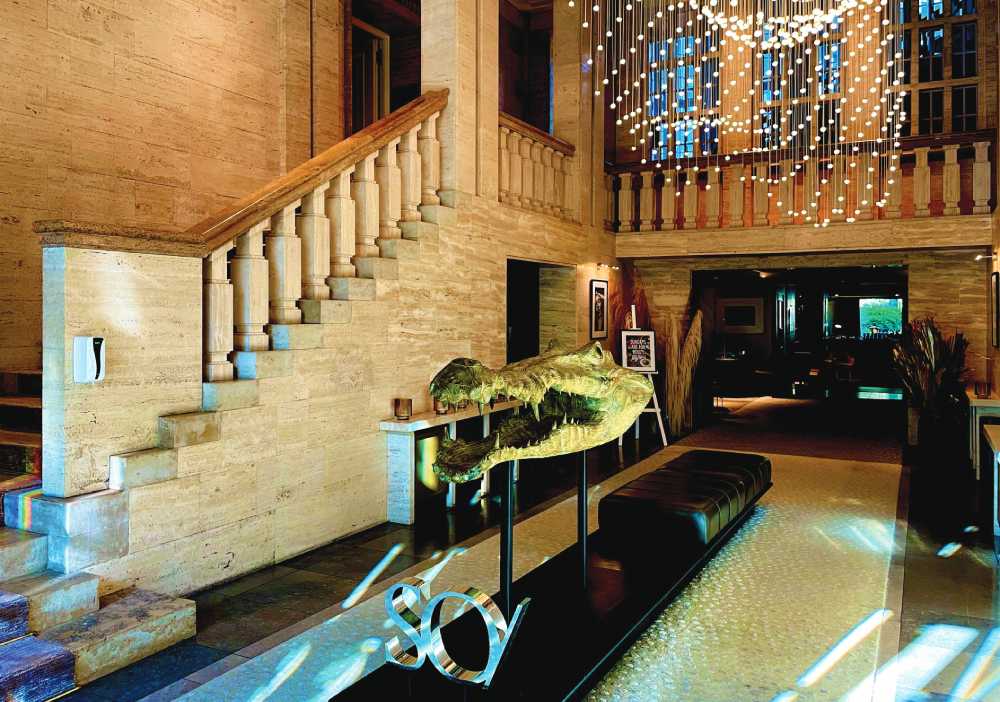

SO Berlin Das Stue Lobby (Photo by Jim Gladstone)
Ulrichs began to promote the notion of social acceptance of gays and lesbians and to protest longstanding laws against homosexual acts early as 1864, a year before the end of the U.S. Civil War! His efforts were built upon by Dr. Magnus Hirschfeld, both gay and Jewish, who in 1897 organized the Scientific-Humanitarian Committee, widely considered the world’s first same-sex and transgender rights organization. Promoting the notion of “Justice through Science” the group’s public campaigns and political lobbying continued until the rise of the Nazis in the early 1930s, when Hirschfeld’s scholarly Institute of Sexology was sacked and he fled the country. In 1935, Hirschfeld died an exile, in France.
But the work of Ulrichs, Hirschfeld and lesbian counterparts including Johanna Elberskirchen and Toni Schwabe was not in vain. By the 1920s, there were nearly 100 bars, night clubs, and cafés catering to queer clientele who made their way to Berlin from around the world. While hardly embraced by mainstream society, they found the cosmopolitan city amenable to building their own sense of identity and continuing to assert their right to broader acceptance, planting seeds for the movement’s future.
After WWII and a period of dormancy and disarray that continued through the building of the Wall in 1961 and beyond, the torch of queer community and activism was picked up once again on the western side of divided Berlin, centered in the Schoneberg kiez, which today remains the city’s most distinctly gay neighborhood, east or west.
Here, you’ll find storied sites including the former Eldorado an internationally famed queer dance hall and trans gathering spot in the 1920s, immortalized in Christopher Isherwood’s novel Goodbye to Berlin (still marked, but now a supermarket), and the still-thriving art deco style Metropol club, which helped launch the careers of Depeche Mode, Morrissey and the Human League in the 1980s.
Over five dozen queer-focused businesses dot the charming, tree-lined streets of this pink bourgeois area, including Prinznecht, a sprawling pub with indoor and outdoor seating particularly popular for happy hour; the Romeo and Romeo Café; Eisenherz, one of the world’s best remaining literary gay book shops; an outpost of the international Axel gay hotel chain; leather gear superstore Boxer, and bespoke fetish wear tailor shop Butcherei Lindinger.
There are also plenty of small cocktail and cruise bars, although the difference between the two significantly less clear cut that in the U.S.: Virtually every gay bar in extremely open-minded Berlin has a sectioned off darkroom or basement area where casual sexual activity is welcome; establishments that specifically identify themselves as cruising spots are more single mindedly so and frequently require guests to check their clothing or adhere to specific kink dress codes throughout the entire venue.
Make no mistake, while sometimes called a “gay village,” Schoneberg is by no means a gay ghetto, with a diverse population and some of the city’s most appealing shopping and dining options for locals and visitors of any stripe. Chief among these is KaDeWe, Berlin’s department store mecca, founded in 1907. Akin to, but significantly hipper than, Harrod’s in London, its array of luxury fashion includes deep cuts from German menswear brands including Jil Sander’s “German Prada”; club styles by GMBH; and streetwear from Berlin-based Esther Perbandt, selected as “the world’s next great global brand” on Tim Gunn’s “Making the Cut”.
Don’t miss KaDeWe’s gob smacking 6th floor food hall, where you can find all manner of fancy goodies to take home as gifts, including handmade candies, gorgeously packaged preserves, and an extraordinary range of teas and coffees. While here, make sure to enjoy an afternoon’s grazing on 1300 varieties of cheese, a sparkling raw bar selection, and cakes so beautifully decorated they could attend the Met Gala. About a ten minute’s walk from here, in the neighboring Charlottenburg kiez, you’ll find another fabulous spread of edibles at Rogacki, a 94-year-old delicatessen most famed for its smoked fish.
For a romantic evening in Schoneberg, treat your schnuki to dinner at celebrated chef Tim Raue’s handsome Brasserie Colette. Impeccable service and delicious cuisine—tender gnocchi with spring peas and morsels of peach napped in creamy blue cheese, a superb bouillabaisse, pistachio crème brulée—comes at a very fair price.
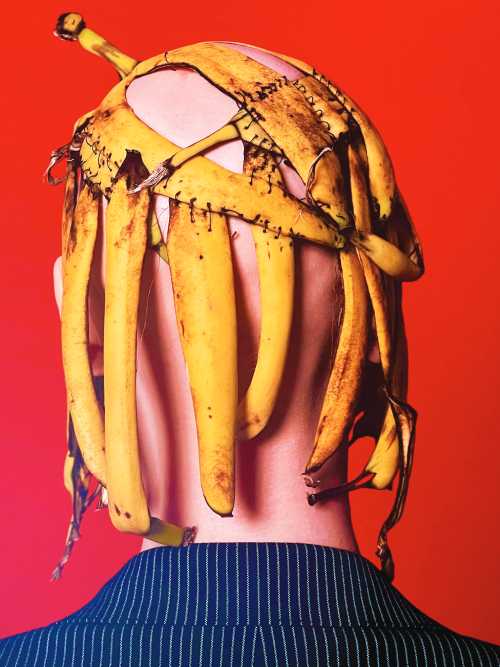

Fruhstuck 3000 Art (Photo by Jim Gladstone)
And if you’re hungry for knockout breakfast or brunch in this gayborhood, don’t miss gay-owned Fruhstuck 3000, a cheeky, creative daytime only joint serving cheddar waffles with chili-bacon caramel and banana bread topped with peanut-chocolate ganache.
WHERE THE OTHER GAYS ARE
While Schoneberg has long been the best known, symbolically central gay district in the city, it no longer represents the cutting edge of queer Berlin. In fact, when I met with 23-year-old Christopher Schneider, an earnest young staff member at the Berlin headquarters of LSVD, Germany’sleading LGBTQ advocacy organization, he explained that his own Gen Z peers tend to spend their leisure time in other quarters of the city, particularly the more easterly Neukolln, Kreuzberg, Friederichshain, and Prenzlauer Berg, considering Schoneberg to represent “old school” points of view.
“It’s mostly popular with people 35 and over,” he articulated. “Many friends my age say its too ‘gay’; that its not a place where people appreciate the ideas of queer and non-binary identity as much.”
In a discussion that would strike many members of the American gay community as familiar, Schneider says that while socially engaged LGBTQ Germans of his generation are sometimes too strident in their focus on proper pronoun use, he also feels that middle-aged and older members of the community have grown overly comfortable and complacent in their expectations and definitions.
“There is a real generational gap,” Schneider acknowledged. “I’ve learned so much about our history from some of my older colleagues, but there is also some lack of tolerance around newer thinking. I really hope that both sides learn to listen to each other more.”
Asked where one could find the city’s most gender, and generationally-inclusive queer nightlife, Schneider recommended SchwuZ in Neukolln. I found his tip to be spot-on when I visited the huge hybrid nightclub and cultural center on a late Friday night when close to a thousand partiers from their twenties through their sixties cheerfully shared multiple dance floors, one of which was dedicated to new mixes of old Madonna.
Now in its fourth and largest location, SchwuZ has served as a progressive meeting place since 1977, and hosts not only late night dance parties, but readings, lectures, cabaret shows, films, and concerts. Long a booster of queer artists and activists, in 2021, it established a non-profit charitable foundation to provide formal means of financial support.
Also beyond Schoneberg, Berlin boasts an extraordinary number of sex-positive queer and all-inclusive venues, parties, and periodically scheduled one-night takeovers of more mainstream spaces. Among those worth checking out are Chantal’s House of Shame extravaganzas held every Thursday night at the Suicide Circus club and the every night camp of Monster Ronson’s Ichiban Karaoke, both in Friedericshain; the open-to-all Turkish and Arabic queer party Gayhane held every fourth Saturday; and the shoulder-to-shoulder cramped kitsch bars Mobel Olffe (a former furniture store with lots of remnant merchandise to lounge on), and Rose’s, in Kreuzberg.
It can be hard to stay on top of Berlin’s robust and ribald queer scene, with new events and venues constantly popping up. Fortunately, given its status as a major economic generator and international draw, the city’s tourism bureau proudly provides regularly updated information and links to even some of the more outrageous on its own website, VisitBerlin.de.
You can also feel entirely comfortable asking for specific advice on queer nightlife and cultural activities at any of the hotels in the Pink Pillow Collection, a network of specially trained and certified accommodations that are particularly hospitable to LGBTQ guests and committed to keeping up with Berlin’s distinctive offerings for gay visitors. You’ll find Pink Pillow members located in virtually any kiez you’d like to lay your head in, including accommodations ranging from hostels to B&Bs to five-star brands.
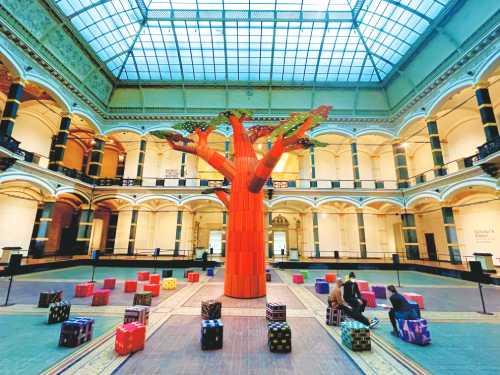

Art Installation at Gropius Bau (Photo by Jim Gladstone)
I luxuriated through my last two days in the city at one of the latter, the spectacularly situated SO/Berlin Das Stue. In a former Dutch embassy building tucked in a tranquil diplomatic enclave on the edge of the Tiergarten, the hotel is a short walk from the Schwules Museum of gay history. An inviting sunlit garden has its own private entrance to the Berlin zoo. And if giant pandas aren’t a sufficiently posh amenity, there’s always the elegant indoor pool and sauna, a library piled with Taschen art books, and the hotel’s own art collection which pays whimsical to the neighboring menagerie. The staff even wear custom-designed Victor & Rolf uniforms with clever animal motifs (and remember, this being a Pink Pillow establishment, you can feel free to inquire about spots to meet bears, otters and other local wildlife).


